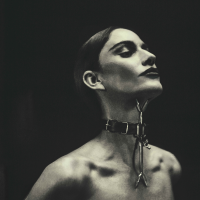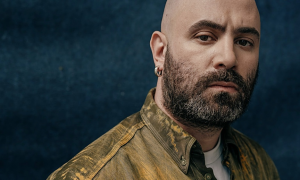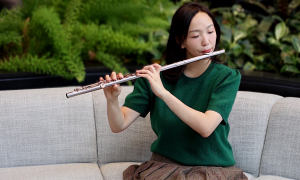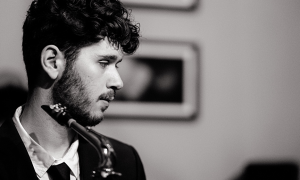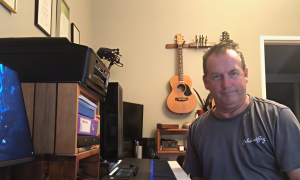Home » Jazz Articles » Take Five With... » Take Five with Tubist Jim Shearer
Take Five with Tubist Jim Shearer

Meet Jim Shearer
Jim Shearer was born in Water Valley, Mississippi, in 1964. His family owned the local newspaper, The North Mississippi Herald, from 1943-2004, and his father was an active musician on the side, playing jazz saxophone and serving as Minister of Music at the family church (but never at the same time!). After spending several years as a flautist at a young age, Jim became a tubist because no one else in the beginning band would play the instrument. The rest, as they say, is history! After graduating from the Eastman School of Music in 1990 with a DMA in tuba performance, he taught briefly at Southern Arkansas University before establishing a long-term career at New Mexico State University, where he currently serves as the Regents Professor of Music. An active performer, Jim divides his time between classical music and jazz. He has released six recordings and two digital singles on the Summit Records label, including his most recent project, Cloud Bowling with Claude Bolling. He makes his home in Las Cruces, New Mexico with his wife and classical performing partner, horn player Celeste Shearer.Instruments:
I've been playing tuba since the fifth grade. Though I learned to play most everything taking music education classes during my undergraduate degree, tuba is pretty much the only thing I'll play in public these days. I'm honored to be a Yamaha performing artist, and for gearheads, I play a custom Yamaha 621 F tuba with a stock Miraphone TU-23 (the old C4) mouthpiece, though I'd be happy to create a custom mouthpiece if any manufacturers out there would like an endorsement!Teachers and/or influences?
My formal tuba teachers included Barton Cummings, Ed Bahr, and Cherry Beauregard. They were all fantastic teachers, but perhaps my biggest mentor was the relationship I formed with the late Sam Pilafian. Sam had an amazing ability to cut through all the clutter and really helped me focus on what was most important in my playing. In my first classical lesson with him, he paid me perhaps the biggest compliment of my life. After I'd been playing for about 20 minutes, he said, "you're a jazz player aren't you? I can hear it in your phrasing." Sam was deeply committed to bridging the jazz and classical worlds, and much of what I've done with my playing career has been heavily influenced by our friendship, which is a story you'll hear from pretty much everyone who spent time with him. In the tuba and euphonium world, we're also lucky to have a very strong professional organization, the International Tuba and Euphonium Association, and for over 50 years now it has provided an excellent safety net for young players and a great place for professional communication and collaboration.I knew I wanted to be a musician when...
I'd been playing tuba for about a year and half, and as a seventh grader I won a few auditions for high school band clinics. Suddenly I was traveling around the state, hanging out with much older students and playing in great bands. I was hooked. Though I spent a lot of time listening to jazz as a young musician, playing jazz on tuba came a bit later for me when I moved to Las Cruces for graduate school in the mid-'80s. I'd been in town less than a week when I got a call to play a dixieland gig with the Creole Jazz Band. I found myself in a truly world-class traditional jazz band with very serious players and really found my musical home. I've spent the rest of my career traveling back and forth between the jazz and classical worlds.Your sound and approach to music.
The great tubist Arnold Jacobs taught "song and wind," which Sam Pilafian and others interpreted basically as "always tell a story." Throughout my career, I've picked projects working with great classical composers and fantastic jazz musicians who were always willing to do the unusual, often letting the tuba step out front and be the soloist. After many of the great traditional jazz guys I played with passed away, I also found myself singing more and more because no one else was willing. There I'm just trying to get the words right and make the changes!Your teaching approach
My teaching career is somewhat unique, in that I teach everything from undergraduate music appreciation to non-music majors, both jazz and classical, all the way through intensive graduate music classes in history and research methods. For many years, I was also a studio tuba and euphonium teacher. Not to keep harping on my association with Sam Pilafian, but basically, I fully embrace his philosophy that you teach the student in front of you, meeting them where they are and finding the best way to help them move forward. There's simply no single path to learning. Out of a class of 200 or more non-majors, if I can get a few to come out to some live shows and buy that old Kind of Blue album (or just add it to their playlists these days!) my work is done.Your dream band
I became a huge Leon Redbone fan in high school, and I always dreamed of playing tuba for him. It never happened, but over the years I've gotten to work with a number of musicians he did record and perform with. Those gigs have all been dream bands for me. Playing tuba with the Jim Cullum Jazz Band, the Dukes of Dixieland in their prime, Lu Watters and the Yerba Buena band, etc...any of those would also be my dream gig. As Steve Martin wrote in L.A. Story: "Let your mind go, and your body will follow." In my heart of hearts, being a traditional jazz tuba player is where I feel the most free and at home.Road story: Your best or worst experience
I spent three years during my undergraduate degree playing tuba in a five-piece rodeo band. It's a bit of a lost art now at rodeos, but back in the day, it was like a circus band gig on steroids. One weekend we'd be on the back of a flatbed trailer in Eclectic, Alabama (yes, that's a real place...look it up. It's about an hour south of the middle of nowhere!), and the next weekend we'd be in the Superdome in New Orleans. So many crazy memories from those times, like having to play the "Coke Song" in Paducah, Kentucky for about 35 minutes straight when the lights went out because the local Coke distributor was the show sponsor. On a visit to New Orleans in the early '90s, I took my horn to Fritzel's, hoping I could sit in for a tune or two. Pianist David Boeddinghaus (who played with Leon Redbone) and clarinet legend Jack Maheu were playing a duo gig that night. They were very generous to let me play a couple of tunes, and when I went to leave the stand they said, "hey, where are you going?" Long story short, I played all night, and as fantastic musicians from all over town finished their gigs, they all came to sit in. I got to play with so many amazing traditional jazz musicians that night... wish someone had made a recording, but it was long before cell phones and such. Now it's just a special memory I hold in my heart, and my wife was there as a witness. It really did happen!Favorite venue
My best classical gig was perhaps with the Eastman Wind Ensemble in 1990. We did a 21-day tour of Japan, where we performed 19 shows and made a record titled Live In Osaka for Sony Classical. It was the only extended tour I've ever done where I never had to carry my own horn, take care of my own wardrobe, or deal with any travel plans. It was true "rock star" time, so I guess I peaked at 26 years old! For jazz, I love any club where I'm up close and personal with the audience. I find myself playing jazz a good bit in more formal academic venues, and while I'm honored to have the gigs, it's tougher to really connect with the audience on that deeper level that a jazz experience can, and should, offer.Your favorite recording in your discography and why?
Ugh, that's like asking which child or dog is my favorite. Each of my recording projects have unique qualities that make them special. If I had to pick, I'd have to say getting to record The Memphis Hang with Charlie Wood back in 2007. I learned so much about the recording process on those sessions, and we had an absolute blast making the record. It was a true musicians' "hang" in every sense of the word. And, the success of that first recording project helped me realize that I could manifest these projects into being. All it took was time, money, and colleagues willing to come along for the ride with a tuba player.What do you think is the most important thing you are contributing musically?
As a tubist, for me it's twofold. For audiences, the nicest compliment I get is, "I had no idea you could do that on a tuba!" In both the classical and jazz worlds, I'm trying to help people understand that the tuba can do pretty much anything else any other instrument can do. In the classical and academic worlds, I'm trying very hard to work with composers and expand the literature for my instrument. For all of my classical recordings, and also with the Cloud Bowling suite for tuba and jazz trio by Chris Reyman on this new project, supporting the composers I work with and putting new or overlooked literature out into the world for future generations is always at the forefront of what I've been trying to do throughout my career.Did you know...
I got to cook for several years on a Memphis in May barbeque team called The Count Bastie Porkestra. Led by trumpet-player and composer/arranger Tom Clary, the team had several big wins over the years, and I helped! I specialized in the seafood category, where I created a great smoked shrimp recipe; it never won, but it was a fan favorite. We'd go through 25-30 pounds of shrimp each year.The first jazz album I bought was:
Well, I didn't buy them, but the first four influential albums I can remember from my father include a Ray Charles Greatest Hits recording, Ellington Indigos by Duke Ellington and his orchestra (great Billy Strayhorn charts there), Julie London Cry Me A River (with Barney Kessel and Ray Leatherwood), and Lavender Sax by the often-overlooked Clifford Scott. I think the first album I "bought" was a Louis Armstrong album I made my mother get with S&H Green Stamps. Yes, I'm really that old. As I came into my high school years in the late '70s and early '80s it was the typical Maynard Ferguson, Chuck Mangione, Spyro Gyra, Brecker Brothers, and The Manhattan Transfer type stuff. It was about then I got deep into vibe playing as well and was listening to MJQ and Milt Jackson's solo stuff, Gary Burton, Cal Tjader and, of course, Lionel Hampton. And, as a School House Rocks! junkie, I was really getting into Dave Frishberg, Bob Dorough, Blossom Dearie and such throughout my early record buying years. Those are all recordings I still regularly listen to and lecture about today.Music you are listening to now:
Brad Mehldau: Your Mother Should Know (Nonesuch Records)John Stein (with Cindy Scott, vocals): No Goodbyes (Whaling City Sound)
Emmet Cohen (featuring Houston Person): Masters Legacy Series, Vol. 5 (Bandstand Presents)
Hiromi: Sonicwonderland (Telarc)
Jim Self & John Chiodini Quintet: Touch and Go (Basset Hound Music)
Desert Island picks:
Chet Baker: My Favorite Songs: The Last Great Concert (Enja Records)Duke Ellington: Ellington Indigos (Columbia)
John Coltrane and Johnny Hartman: John Coltrane and Johnny Hartman (Impluse)
Ray Charles and the Count Basie Orchestra: Ray Sings, Basie Swings (Tangerine Records)
Siegel-Schwall Band: 953 West (Wooden Nickel Records)
How would you describe the state of jazz today?
It's so hard to really say. Out here in New Mexico where I live, it's a bit "hit or miss." We do the annual Roswell Jazz Festival, which is great, but then it's no real gigs for months. Every time I travel, I'm blown away by how much young (and old) talent is out there working on a regular basis. We recently lived in Pittsburgh for five weeks, and I was catching two or three live jazz events a day. Go to the Con Alma club if you're ever there, and make sure to keep an eye out for Matthew Whitaker. He's simply a mind-blowing young musician. Access to great music is so different now. It's amazing, but I think it can sometimes be overwhelming. I remember seeing Dave Frishberg on the Tonight Show in 1980 and driving an hour and a half to a record store to find his album. Today, I always feel like I must be missing something! On the other hand, with my students, I sometimes find it hard to get them to focus on something longer than a minute or two. How do you TikTok a Mahler symphony, or even great albums like Kind of Blue or A Love Supreme? Sometimes all I get for feedback is "too long, no words." It's one of the reasons I give so much respect in my class to artists like Postmodern Jukebox, Jamie Cullum, Jacob Collier, Esperanza Spalding, Lake Street Dive, Snarky Puppy, and the like. They are truly making an effort to successfully bridge the gap between pop culture and real jazz.What are some of the essential requirements to keep jazz alive and growing?
Education, plain and simple. How can we expect to keep this artform alive if we don't teach each successive generation about this amazing and truly unique style of music. In my experience, if you can just get them to listen, the rest takes care of itself. It's getting people to come to the party these days that is the hard part.What is in the near future?
We're doing a few CD release shows to promote our new Cloud Bowling with Claude Bolling project, hopefully with some jazz festival and conference performance dates for the group further down the line. I've also got a really special show coming up playing tuba in a band backing up the amazing Gunhild Carling, which I'm hoping might lead to more dates in the future. I serve as principal tubist in two regional symphonies and play in the NMSU Faculty Brass Quintet, so those gigs are always happening, and I've got a brand-new classical trio show coming up soon with my wife, Celeste, where we'll be premiering some new music for horn, tuba, and piano, along with revisiting a few works we commissioned and recorded years ago but that we haven't played in a while.What is your greatest fear when you perform?
Chipping notes in the classical world and simply not making the changes in jazz. You study all those great books that say "play a flat 9th here or a sharp 11th there," but with the tuba, that often ends up as a minor 2nd against the bassist or the left hand of the piano. I hate it when things I think are going to work great sound far more dissonant than I intended. And, of course, not saying something musically and telling a story that brings the audience along is always a concern; you've got to tell a musical story.What song would you like played at your funeral?
Soul Intro. and "The Chicken" off Jaco Pastorius' The Birthday Concert album, or, even better, played live by a band if we can get that many musicians to come!What is your favorite song to whistle or sing in the shower?
I'm always working on new literature, both classical and jazz, so my shower singing is whatever I'm working on at the moment, which is most likely what I've been singing every time I wake up in the middle of the night as well.By Day:
Life in music is 24/7 for me. I play it, I teach it, and I'm always going back and forth between the classical and jazz worlds and between the worlds of commercial music and academia. The fun never stops!If I weren't a jazz musician, I would be a:
I'd probably still be in the family newspaper business where I grew up in tiny Water Valley, Mississippi. I was taken to the Herald office when I was ten days old, and I worked there regularly until I went away to college. Since then, I've gone back at various points in my career to help out at the paper during family illnesses and my father's untimely death in 2003, and that work is something that comes very naturally to me. I still write the occasional human-interest column when the mood strikes me.If I could have dinner with anyone from history, who would it be and why?
Louis Armstrong, without a doubt. So many great stories I'd love to hear him tell!If I could go back in time and relive an experience, what would it be?
I was talking about this in another interview not long ago, and it's something I've always been interested in. I think it would have been life-changing to have been in the room the night Louis Armstrong and Bix Beiderbecke jammed together. Louis spoke about it and wrote about it on several occasions. That must have been an amazing night! I spend time each semester teaching non-music majors about the famous Benny Goodman Carnegie Hall concert in 1938. That would have been pretty incredible to see and hear. And for me, just because I love the music so much, to see Django and Stéphane with the Hot Club Quintette when they were in their prime would have been simply amazing. Wow!After living in New Mexico for so long, exactly how addicted are you to green chile?
Man, I'll tell you, when they start roasting green chile out here in early August each year, the smell is mesmerizing. You are always hungry for more chile. That smell gets in your soul! On a typical year, we put up between 120 and 160 pounds of green chile, including a variety of medium and hot peppers, along with a few pounds of what we call "stupid hot." We've run out in April or May a few times, and that's a chance we're just not willing to take again!Tags
Take Five With...
Jim Shearer
AAJ Staff
Summit Records
New Orleans
Ray Charles
duke ellington
Billy Strayhorn
Julie London
Barney Kessel
Clifford Scott
Louis Armstrong
Maynard Ferguson
Chuck Mangione
Spyro Gyra
Brecker Brothers
Manhattan Transfer
Milt Jackson
Gary Burton
Cal Tjader
Lionel Hampton
Dave Frishberg
Bob Dorough
Blossom Dearie
brad mehldau
John Stein
Emmet Cohen
Hiromi
Jim Self
Chet Baker
John Coltrane
Johnny Hartman
Roswell Jazz Festival
Pittsburgh
Con Alma
Matthew Whitaker
Postmodern Jukebox
Jamie Cullum
Jacob Collier
Esperanza Spalding
Lake Street Dive
Snarky Puppy
Bix Beiderbecke
Benny Goodman
Jaco Pastorius
PREVIOUS / NEXT
Support All About Jazz
 All About Jazz has been a pillar of jazz since 1995, championing it as an art form and, more importantly, supporting the musicians who make it. Our enduring commitment has made "AAJ" one of the most culturally important websites of its kind, read by hundreds of thousands of fans, musicians and industry figures every month.
All About Jazz has been a pillar of jazz since 1995, championing it as an art form and, more importantly, supporting the musicians who make it. Our enduring commitment has made "AAJ" one of the most culturally important websites of its kind, read by hundreds of thousands of fans, musicians and industry figures every month.









